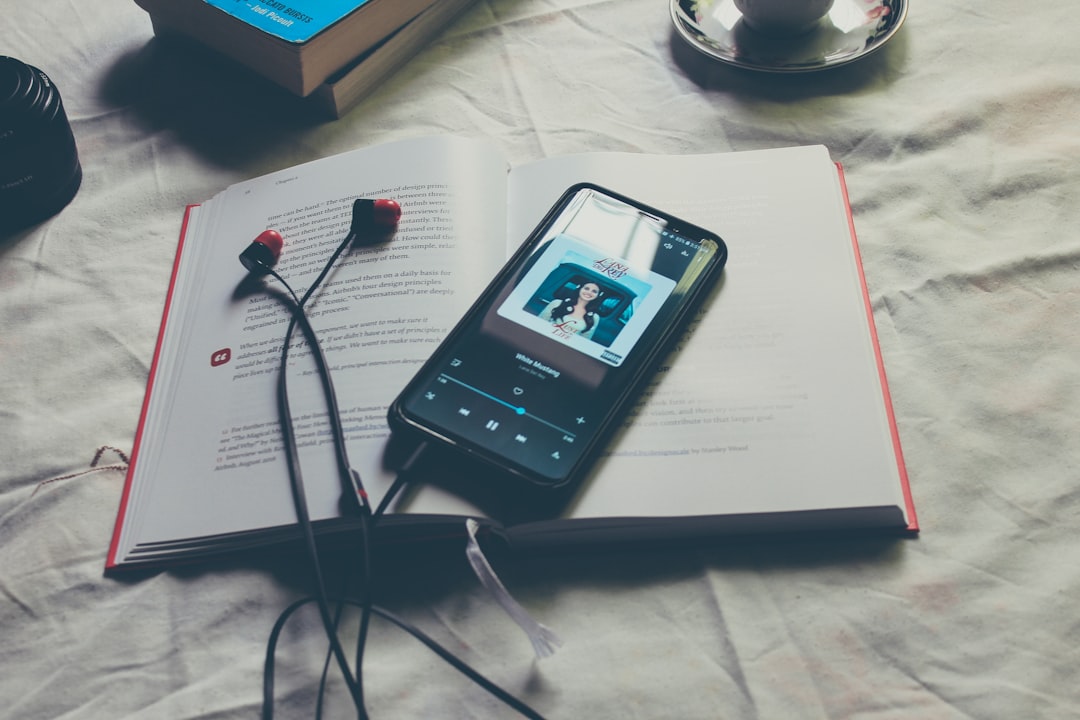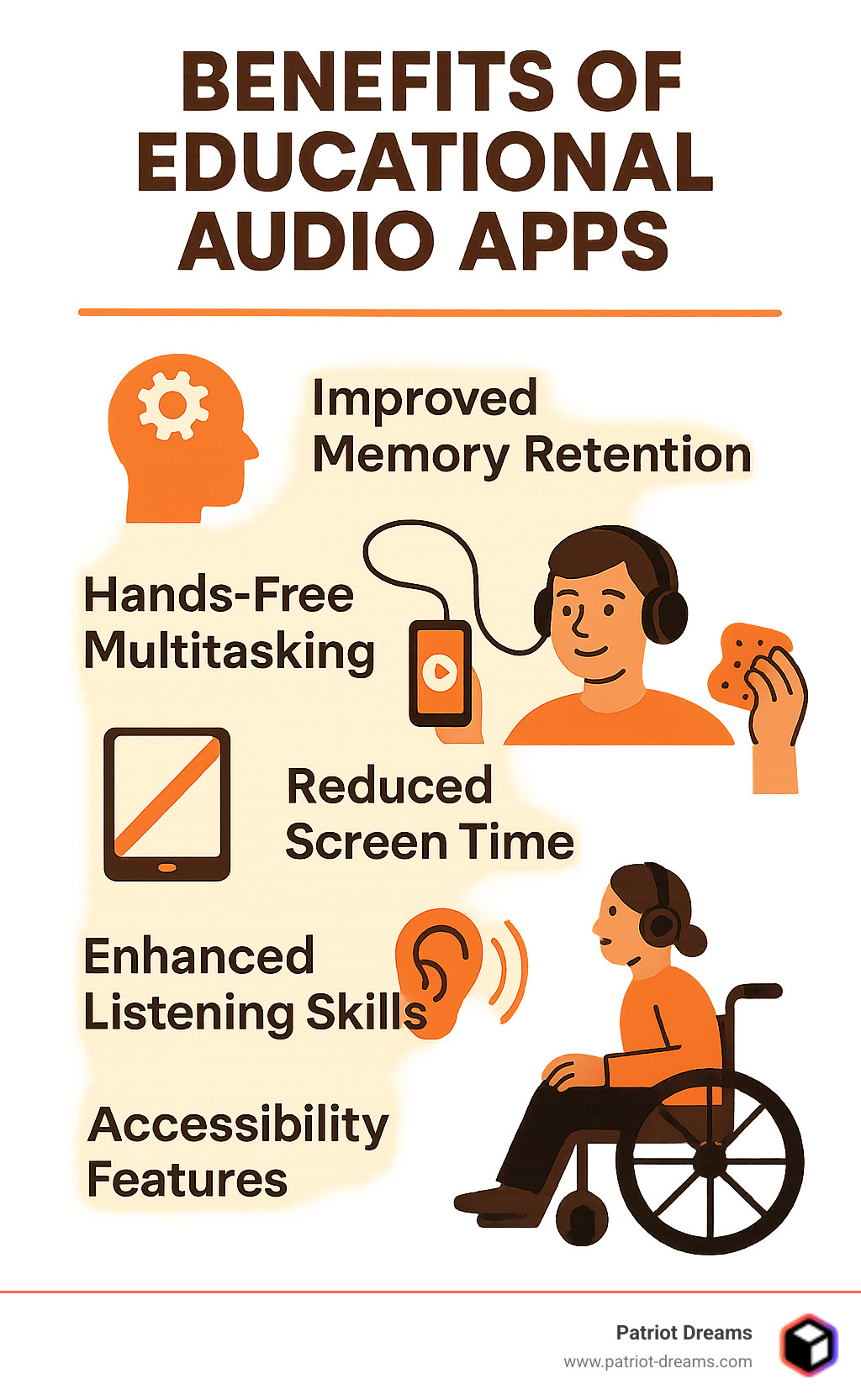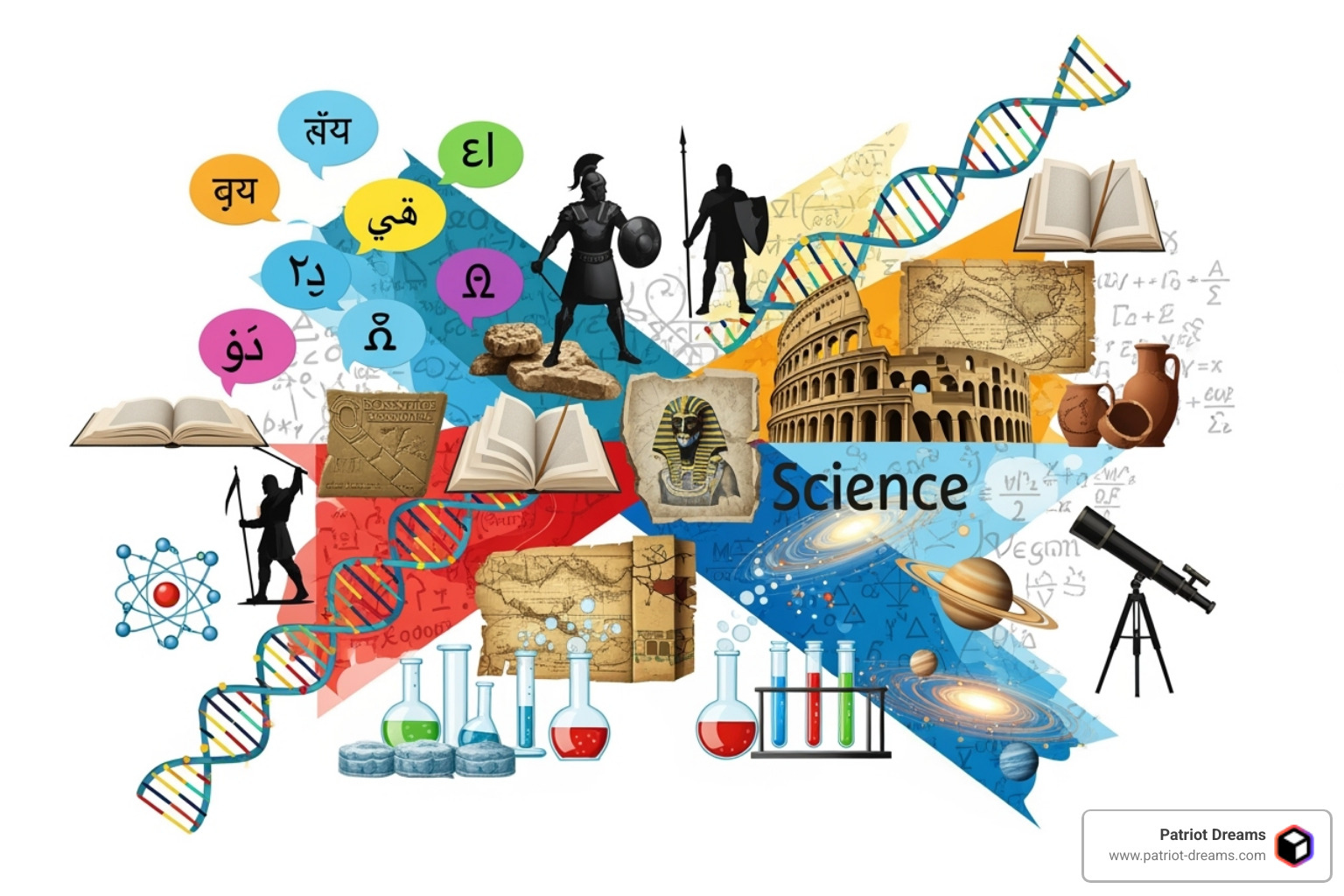Your Ears Are Your Classroom: A Roundup of Educational Audio Apps


Why Audio Learning is Revolutionizing Education
An Educational audio app transforms your daily routine into learning opportunities, letting you absorb knowledge while commuting, exercising, or doing chores. These apps deliver content through podcasts, audiobooks, and interactive lessons that make learning accessible anytime, anywhere.
Top Educational Audio Apps at a Glance:
- Language Learning: Apps offering immersive practice and conversational skills.
- Academic Subjects: Platforms with curriculum-aligned content and general knowledge lessons.
- Children's Education: Apps focused on screen-free storytelling and personalized content.
- Accessibility: Services providing assisted reading for diverse learners.
- Heritage & History: Specialized apps for cultural exploration and family stories.
The numbers tell the story: families using audio learning apps reduce screen time by 4-5 hours per week on average, and some popular platforms serve millions of learners across dozens of languages. As one parent shared about their experience with audio learning: "My daughter was so focused on a story that she didn't ask for her phone during a car ride."
Audio learning works because it taps into how our brains naturally process information. Unlike passive reading, active listening engages multiple cognitive pathways, making it easier to retain information while multitasking. Whether you're a visual learner who benefits from narrated content or an auditory learner who thrives on spoken instruction, educational audio apps offer a flexible path to knowledge.
For history enthusiasts and families looking to explore American heritage, these apps provide immersive storytelling that brings the past to life. They also offer tools to document and preserve your own family stories, creating audio legacies for future generations.

The Rise of Audio Learning: Why Tune In?
Picture this: you're stuck in traffic, but instead of feeling frustrated, you're transported to colonial America, listening to fascinating stories about the founding fathers. Or maybe you're folding laundry while learning about the Civil War. This is the beauty of an educational audio app – it transforms ordinary moments into extraordinary learning opportunities.
We live in a world where finding dedicated study time feels nearly impossible. Traditional learning demands your full attention, a quiet space, and often a significant time commitment. Audio learning flips this script entirely. It seamlessly weaves education into the fabric of your daily routine, turning what used to be "dead time" into valuable learning experiences.
The real game-changer? Multitasking without compromise. While your eyes focus on the road or your hands tackle household chores, your mind can absorb new information effortlessly. This hands-free approach doesn't just make learning convenient – it offers a welcome break from our screen-dominated lives.
Parents especially love this benefit. One family shared how audio apps became their "secret weapon" for road trips, keeping kids engaged and learning without any screens in sight. Some families report reducing their weekly screen time by 4-5 hours simply by choosing audio content over visual media.
Catering to Different Learning Styles
Not everyone learns the same way, and that's perfectly okay. While many people are visual learners, a significant portion of us actually learn best through auditory input. For these listeners, an educational audio app feels like finding a superpower they never knew they had.
Think about it – when someone tells you a captivating story, your imagination kicks into high gear. You visualize the characters, picture the scenes, and emotionally connect with the narrative. The same thing happens with educational audio content. Whether you're exploring historical events, learning about science, or finding family heritage, the spoken word creates powerful mental connections.
But here's the beautiful part: even if you don't consider yourself primarily an auditory learner, audio apps offer incredible benefits. They reinforce concepts you've learned through other methods, making information stick better. For language learners, they provide invaluable pronunciation practice and expose you to natural speech patterns. The immersive storytelling experience often makes complex topics feel more accessible and memorable than traditional textbooks ever could.
Research suggests that active listening can actually double memorization capacity compared to passive reading. When you're truly engaged with audio content, your brain works harder to process and retain the information.
Audio vs. Traditional and Digital Formats
So how does audio learning stack up against traditional textbooks or other digital formats? The differences are striking, and they're all in audio's favor.
Flexibility is audio's greatest strength. Unlike heavy textbooks that live on your shelf or online courses that chain you to a computer, audio content travels with you everywhere. Your smartphone becomes a portable library, ready to educate you whether you're walking the dog, commuting to work, or taking a lunch break.
This flexibility also means reduced screen time – a blessing in our device-heavy world. Your eyes get a rest while your mind stays active. Parents particularly appreciate this benefit, as it gives children educational content without adding to their daily screen exposure.
Active listening naturally improves your listening comprehension skills. This is especially valuable for understanding different accents, speech patterns, and communication styles. Unlike passive reading, listening demands engagement – you can't just glance over words and move on.
For people with learning differences or visual impairments, audio apps open doors that traditional formats might keep closed. Text-to-speech functionality, adjustable playback speeds, and compatibility with assistive technology make learning truly accessible to everyone.
Perhaps most importantly, audio learning doesn't try to replace traditional methods – it complements them beautifully. Use audio for initial exploration of topics, reinforcement of classroom learning, or simply to deepen your understanding through a different medium. It transforms learning from a chore into an trip.
The beauty of audio learning lies in its ability to meet you where you are, fitting seamlessly into your life rather than demanding you rearrange your schedule around it. More info about our features shows how this principle comes to life in practical, engaging ways.
Key Features of a Top-Tier Educational Audio App
What separates a good educational audio app from a truly great one? It's not just about playing audio content. The best apps create an engaging, interactive experience that makes learning stick. Think of it as the difference between passively listening to the radio and having a conversation with a knowledgeable friend.
The most effective apps understand that our brains learn better when we're actively involved. They don't just talk at us – they engage with us. This means creating tools that help us practice, and apply what we've learned.
Essential Interactive Tools
The magic happens when an app transforms listening into doing. Quizzes and challenges turn passive listening into active recall, helping cement new knowledge in our minds. When we hear about the Boston Tea Party and then immediately answer questions about it, we're far more likely to remember those details weeks later.
Spaced repetition systems work like a personal memory coach. They introduce new concepts, then bring them back at just the right moments to strengthen our recall. It's like having a friend who knows exactly when to remind you of something important before you forget it.
For language learners, voice recording and pronunciation feedback features are game-changers. Being able to record yourself saying a word and compare it to a native speaker is like having a patient tutor available 24/7. This immediate feedback helps build confidence and accuracy.
Note-taking capabilities let us capture those "aha!" moments as they happen. Whether we're walking the dog or cooking dinner, we can quickly save important insights without breaking our stride. Some apps even create custom glossaries from our notes, building a personalized reference library.
Gamification elements like points, levels, and badges tap into our natural love of achievement. Learning becomes less like homework and more like playing a game where the prize is knowledge.
Content and Accessibility Features
Great content starts with high-quality audio that's crystal clear and professionally produced. When learning about complex topics, every word matters. Native speaker narration is especially crucial for language learning and historical content, bringing authenticity and proper pronunciation to the experience.
A diverse content library ensures there's something for everyone. Whether you're interested in American history, science breakthroughs, or personal development, variety keeps learning fresh and exciting. The best apps offer content for all levels, from beginners taking their first steps to advanced learners diving deep into specialized topics.
Adjustable playback speed might seem like a small feature, but it's incredibly powerful. You can slow down complex explanations until they click, or speed through familiar material to save time. It's like having a volume control for learning pace.
Transcripts and accessibility features make learning inclusive for everyone. Synchronized transcripts help visual learners follow along, support those with hearing difficulties, and make content searchable. Some apps offer features like text highlighting that follows the audio, creating a bridge between listening and reading.
Offline access ensures that learning never stops, even when WiFi doesn't cooperate. Download content before a flight or road trip, and your education continues uninterrupted.
The best educational audio app feels less like a tool and more like a learning companion – one that adapts to your style, remembers your progress, and makes knowledge accessible wherever life takes you.
A World of Knowledge: Educational Audio App Categories

The world of educational audio apps is like a vast library where every subject has found its voice. Whether you're curious about ancient civilizations, eager to master a new language, or passionate about scientific findies, there's an audio experience waiting to capture your imagination. What makes this landscape so exciting is how each category has evolved to use sound in unique ways that bring learning to life.
Language Immersion and Practice
Language learning through audio feels natural because it mirrors how we first learned to speak as children. We heard voices, absorbed patterns, and gradually found our own words. Modern language apps have perfected this approach in remarkable ways. Some use a scientifically-designed method that introduces words, asks you to repeat them, and then brings them back at precise intervals. This spaced repetition system works like magic for pronunciation and listening skills.
Other apps take a different path by letting you sit in on actual classroom recordings. It's like having a patient teacher who breaks language into simple building blocks, helping you construct sentences naturally without memorization drills. Still others create a bridge between languages by showing you stories and articles in two languages simultaneously, proving that learning can be both educational and entertaining.
Educational Audio Apps for History and Science
History and science come alive through audio in ways that textbooks simply can't match. When you hear stories about the past or explanations of complex concepts, your imagination fills in the details, creating lasting memories.
Some apps transform learning into bite-sized trips with short audio stories covering everything from philosophy to the Civil War, proving that engaging content can expand your knowledge painlessly. Others take a comprehensive approach, offering vast catalogs of content in history, art, and science, sometimes with an AI assistant to help clarify doubts. For students, there are platforms that provide expert-led podcasts aligned with school curricula, making complex topics feel approachable. Many large digital libraries are also working to make historical audio collections searchable and accessible, letting you explore oral histories and speeches that bring the past into the present.
Educational Audio Apps for Accessibility and Diverse Needs
Perhaps the most important category is apps that ensure everyone can learn, regardless of their challenges or preferences. These tools demonstrate audio's power to level the educational playing field.
Some services lead this space with millions of accessible titles for people with print disabilities, offering text-to-speech, karaoke-style highlighting, and even braille compatibility. Others focus on giving children a healthy alternative to screens through audio stories, podcasts, and music, which can be particularly helpful for children who learn better while moving. Some apps even use AI to create personalized educational podcasts for children on any topic they're curious about, making learning feel magical rather than forced.
These categories show how educational audio apps have evolved beyond simple recordings into sophisticated learning tools. They prove that when we listen actively, we don't just hear information - we absorb it, imagine it, and make it our own.
Integrating Audio Learning into Your Routine
The real magic of an educational audio app happens when learning stops feeling like work and starts feeling natural. Instead of carving out special study time, you can weave education into the moments that already exist in your day.
Think about your morning commute. Rather than staring at your phone or zoning out to the same playlist, you could be exploring the Revolutionary War or finding stories about your local community's heritage. That's the beauty of audio learning – it fits into the spaces between your other activities.
Independent learners find this flexibility liberating. You set the pace, choose what fascinates you, and dive as deep as you want without anyone looking over your shoulder. Maybe you're curious about Civil War battles during your lunch break, or you want to practice Spanish pronunciation while walking your dog. The learning happens on your terms, in your time.
Educators are catching on to this potential too. Teachers now assign audio content for students to explore at home, freeing up classroom time for discussions and hands-on activities. This flipped classroom approach means students come to class already familiar with the basics, ready to dig deeper into the interesting stuff.
Parents love how audio apps support homework time without adding more screen time to their kids' day. When children can listen to history stories or language lessons while building with blocks or drawing, learning becomes less of a battle and more of a findy.
The on-the-go possibilities are endless. Your daily jog becomes a chance to learn about local historical landmarks. Folding laundry turns into an opportunity to hear family stories from previous generations. Even that mundane grocery store trip can include a quick lesson about the founding fathers.
What makes this work is that audio learning doesn't demand your full attention the way reading does. Your hands and eyes stay free for other tasks while your mind absorbs new information. It's multitasking that actually makes sense.
The key is starting small. Pick one routine activity – maybe your drive to work or your evening walk – and try adding just ten minutes of educational audio. Before you know it, you'll find yourself looking forward to these mini-learning sessions throughout your day.
Navigating the Soundscape: Limitations and Best Practices
Let's be honest – even the best educational audio app isn't perfect for every situation. While we've explored the incredible benefits of audio learning, it's important to understand where these tools might fall short and how to use them most effectively.
Potential Drawbacks
Audio learning works wonderfully for many subjects, but it has its challenges. Visual learners might struggle with topics that really need diagrams, maps, or charts to make sense. Imagine trying to understand the Battle of Gettysburg without seeing the battlefield layout, or learning about cell division without watching the process unfold visually.
There's also the active listening challenge. It's surprisingly easy to let our minds wander while listening, especially when we're multitasking. Unlike reading a book where we can quickly glance back at a missed sentence, rewinding audio can interrupt our learning flow. One minute we're absorbing fascinating facts about the Revolutionary War, and the next we realize we've been thinking about dinner plans for the past five minutes.
Quality varies widely across different apps and content creators. While some platforms feature expert historians and professional narrators, others might rely on computer-generated voices or less experienced speakers. Poor audio quality or monotonous delivery can turn even the most exciting historical events into a cure for insomnia.
The multitasking benefit can backfire too. Learning while driving or exercising requires focus that isn't always available. Safety should always come first, and sometimes our brains simply can't juggle listening and other activities effectively.
Best Practices
The good news? These limitations are easily manageable with the right approach.
Choose your content wisely. Look for apps created by subject experts with strong editorial oversight. Read user reviews and pay attention to audio quality during free trials. Your ears deserve better than robotic narration or factual errors.
Accept hybrid learning. Audio works best when combined with other methods. Take notes while listening, discuss what you've learned with family, or follow up with visual materials. This approach reinforces learning and fills in gaps that audio alone might leave.
Set clear goals before you start. Are you exploring family heritage, preparing for a history exam, or simply satisfying curiosity about American culture? Clear objectives help you choose relevant content and stay focused during listening sessions.
Stay actively engaged with the material. Pause to reflect on what you've heard, repeat interesting facts aloud, or even imagine yourself in historical scenes. Many apps offer quizzes and interactive features – use them to reinforce your learning.
Mind your environment. While audio learning is flexible, complex topics deserve your attention. Save challenging content for times when you can focus, and use simpler material for busy moments.
Use supporting materials when available. Transcripts, maps, and supplementary visuals can improve your understanding and make learning more accessible for different learning styles.
By understanding these considerations, we can harness the full power of audio learning while avoiding common pitfalls. The key is finding the right balance for your learning style and goals.
Conclusion
The journey through educational audio apps reveals something remarkable: we're living through a true learning revolution. These apps have opened doors we didn't even know existed, turning every moment into a potential classroom and every pair of earbuds into a gateway to knowledge.
What strikes us most is how these apps honor the way people naturally learn. Some of us absorb information better through our ears than our eyes. Others need the freedom to move while learning. Many of us simply can't find traditional study time in our packed schedules. Audio learning meets us exactly where we are, whether that's stuck in traffic, folding laundry, or taking an evening walk.
The power of lifelong curiosity becomes real when learning fits seamlessly into our lives. We've seen how some apps turn 10-minute moments into mind-expanding experiences, while others make language learning feel like finding a new world. The beauty lies not just in convenience, but in how audio creates an intimate learning experience – just you, the narrator, and pure knowledge flowing directly into your consciousness.
Personalized education takes on new meaning when we can adjust playback speeds, choose our topics, and learn at our own pace. Whether someone needs transcripts for accessibility, wants to practice pronunciation, or simply prefers learning while moving, today's audio apps adapt to individual needs rather than forcing everyone into the same mold.
The limitations we discussed – like missing visual cues or the need for active listening – become manageable when we approach audio learning thoughtfully. By choosing quality content, setting clear goals, and combining audio with other learning methods when needed, we create rich educational experiences that stick with us long after the audio stops.
For those looking to explore American history through immersive stories, Patriot Dreams offers a unique way to connect with the past. Our platform has unique listening modes that bring American history and personal legacy stories to life. Plus, our interactive map allows you to explore and listen to stories of the places that surround you.
The future of learning isn't about replacing traditional methods – it's about expanding them. It's about recognizing that education happens everywhere, not just in classrooms. Most importantly, it's about making learning so accessible and engaging that curiosity becomes a natural part of daily life.
Join the Patriot Dreams Community
Download the app today and start your journey through American history and personal legacy.

Explore Our Latest Insights
Dive into stories that shape our American legacy.




